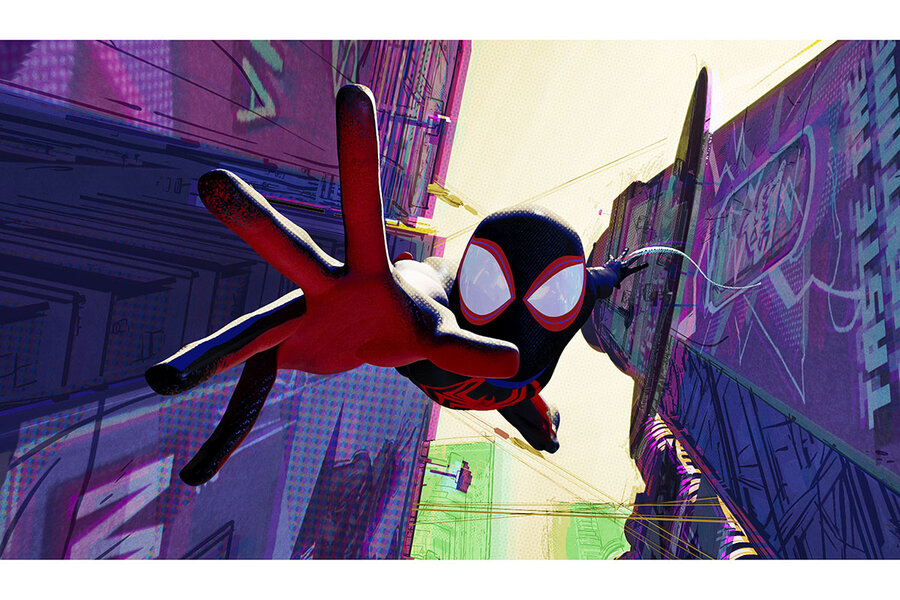Oh, what a web it weaves: ‘Spider-Verse’ spins a high-flying tale
Loading...
With great power comes great responsibility.
It is the phrase that defines a character and quite possibly even a comic universe. Stan Lee and Steve Ditko’s creation of Spider-Man back in the 1960s gave us Marvel’s most relatable hero, due to his awkwardness and the adversity he regularly experienced, whether in his personal or powered-up life.
The phrase took something personal and made it aspirational. There was one unspoken rule: Great power doesn’t just come with great responsibility. It comes with great sacrifice.
Why We Wrote This
A story focused onWhy go see yet another version of everyone’s friendly neighborhood wall-crawler? In addition to captivating animation, this Spider-Man understands the importance not just of responsibility, but also of consequences.
The new “Spider-Man: Across the Spider-Verse,” wants to see just how tensile that tenet is. What results is a masterpiece – a triumph of innovation and diversity that just might be the best comic book movie I’ve ever seen.
My perusal of source material has been vast, from countless comic books to hours of animated series. “Spider-Man,” which aired on Fox from 1994 to 1998, was a go-to in my youth. I remember how the show masterfully spun together storytelling and larger-than-life action. At the time, it, “Batman: The Animated Series,” and “X-Men: The Animated Series,” were industry standard-bearers.
“Across the Spider-Verse,” which opened Thursday, doesn’t just challenge its most iconic phrase – it also challenges what we have seen in previous silver-screen incarnations of Spider-Man.
It picks up right where 2018’s “Into the Spider-Verse” left off, centering its story on the budding friendship between Miles Morales and Gwen Stacy. The plot moves with a teen’s pace, quickly through adolescence and puberty to the fringes of adulthood and responsibility. Both Miles and Gwen aren’t just doing battle with supervillains, but also with overbearing parents.
Saying that the movie brings the comic book to life, or that it jumps off the page, doesn’t do it justice. The Spider-Verse moves fast enough for our attention-deficit age, while also honoring the time-honored traditions of storytelling.
Now, imagine that story reinforcing itself from the perspectives of various griots, or chroniclers, or for the sake of this exercise, spinners. This is where the Spider-Verse series weaves in beautiful diversity, offering an array of Spider-types, unique in nationality, in ideology, in literal construct. The 2018 film came complete with a Spider-robot and a Spider-pig, but the sequel takes the absurdities to another level.
When I saw the legion of Spider-men and Spider-women who chase after Miles in the trailer, I thought about the strands of the Spider story that got my attention. At first, it was the notion of a nerdy kid whose superpowers turned his world upside down. Later, it was the fashion sense of our wall-crawling hero that not only inspired my favorite comic book cover, but a foreshadowing phrase: “Amid the chaos, there comes a costume.”
That versatility doesn’t just remind me of Peter Parker, but also of another famous photojournalist – Gordon Parks. There was nothing he couldn’t do, whether it was photography, writing, directing, or composing. The director of the iconic blaxploitation film, “Shaft,” also composed music for the series.
Spider-Man isn’t without its own infectious jingle. “Is he strong? / Listen, bud – he’s got radioactive blood,” goes the theme from the often-reprised 1967 Spider-Man cartoon. This movie is just as captivating, whether it’s one’s first time engaging with the old webhead, or a tried and true believer who will appreciate the vast number of Easter eggs that the film provides.
With charisma, callbacks, and culture, the movie doesn’t just inspire diversity in terms of representation. It also inspires diversity in terms of how we view choice.
“Everyone keeps telling me how my story is supposed to go,” Morales says defiantly during the trailer. “Nah. I’mma do my own thing.”
What this movie ultimately teaches us through the adaptation of an adage is that great power doesn’t just bring forth added responsibility or sacrifice. The gravity of great power shifts our focus from circumstances to consequences.
I’ve watched superhero movies succumb to the pressure of that existential burden – from the latter Matrix movies to Marvel’s Phase Four. “Across the Spider-Verse,” with all its complexities and previous Spider standards, feels free in its development and execution.
And oh, what a web it weaves.
Correction: Isaac Hayes composed both the music and lyrics for the theme song for the original “Shaft.” Gordon Parks, the director of “Shaft,” composed music for additional films in the series.






